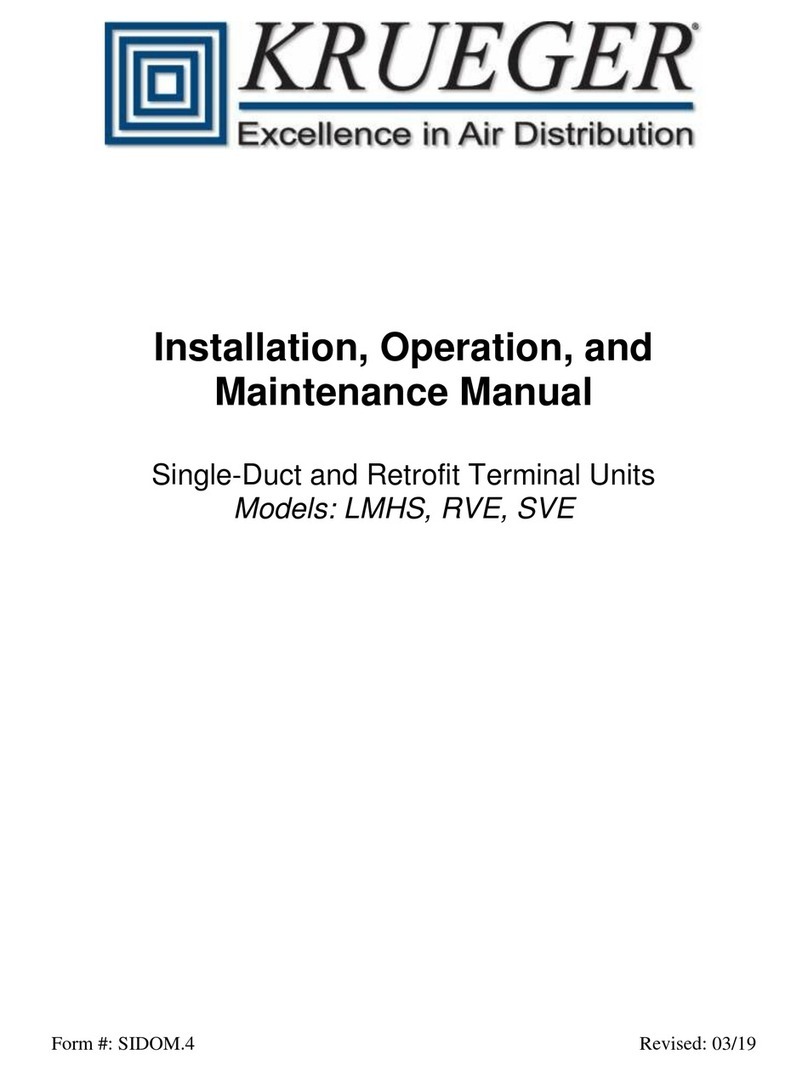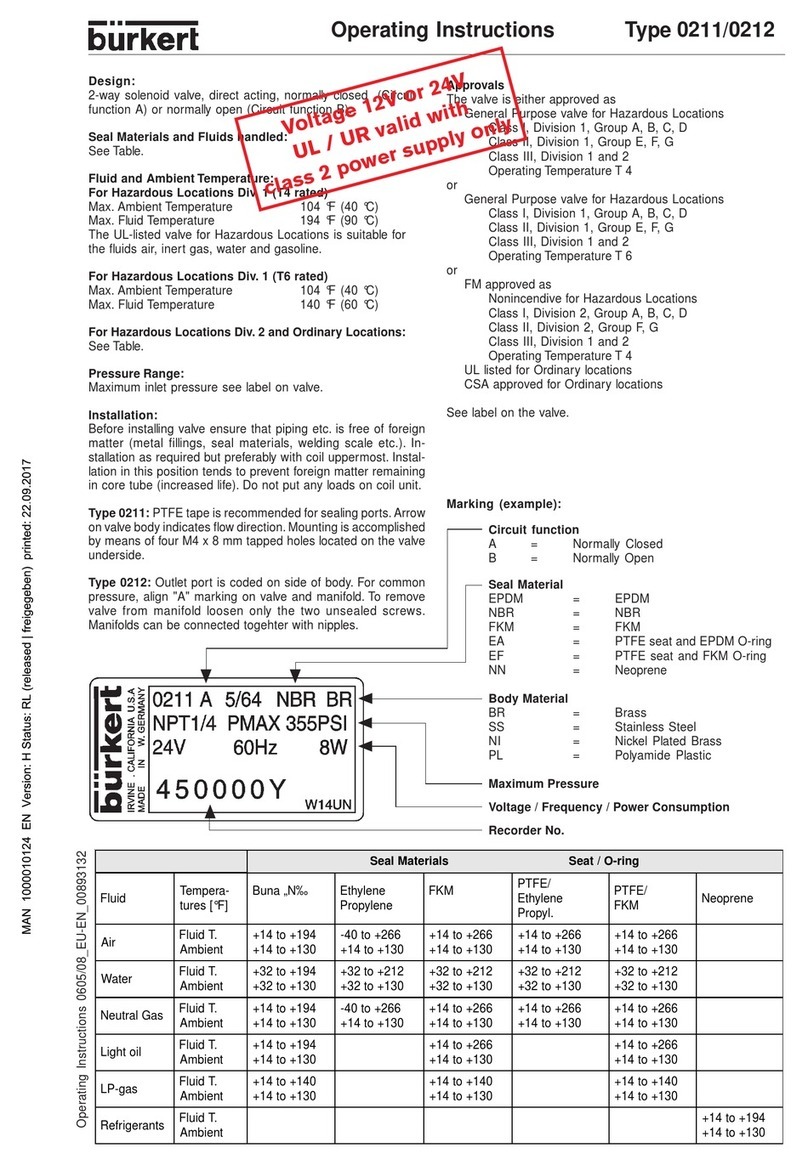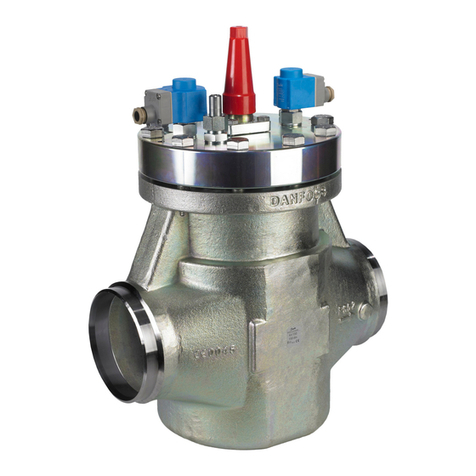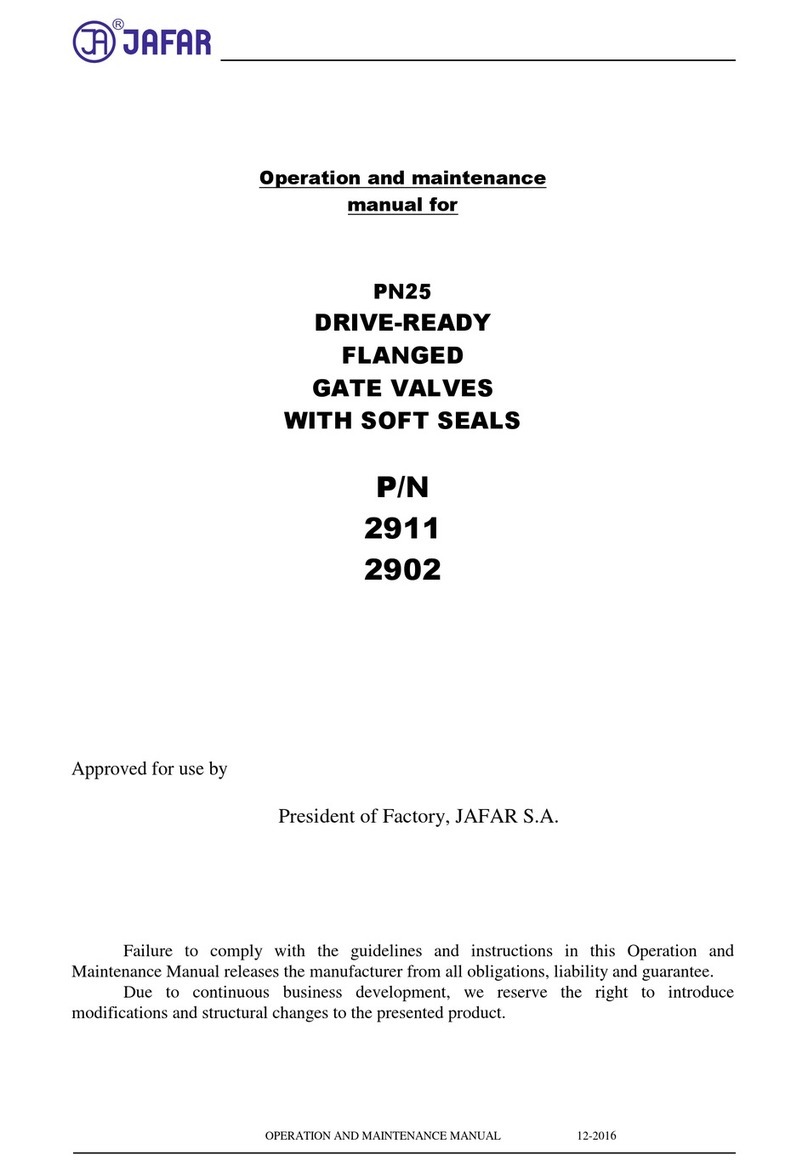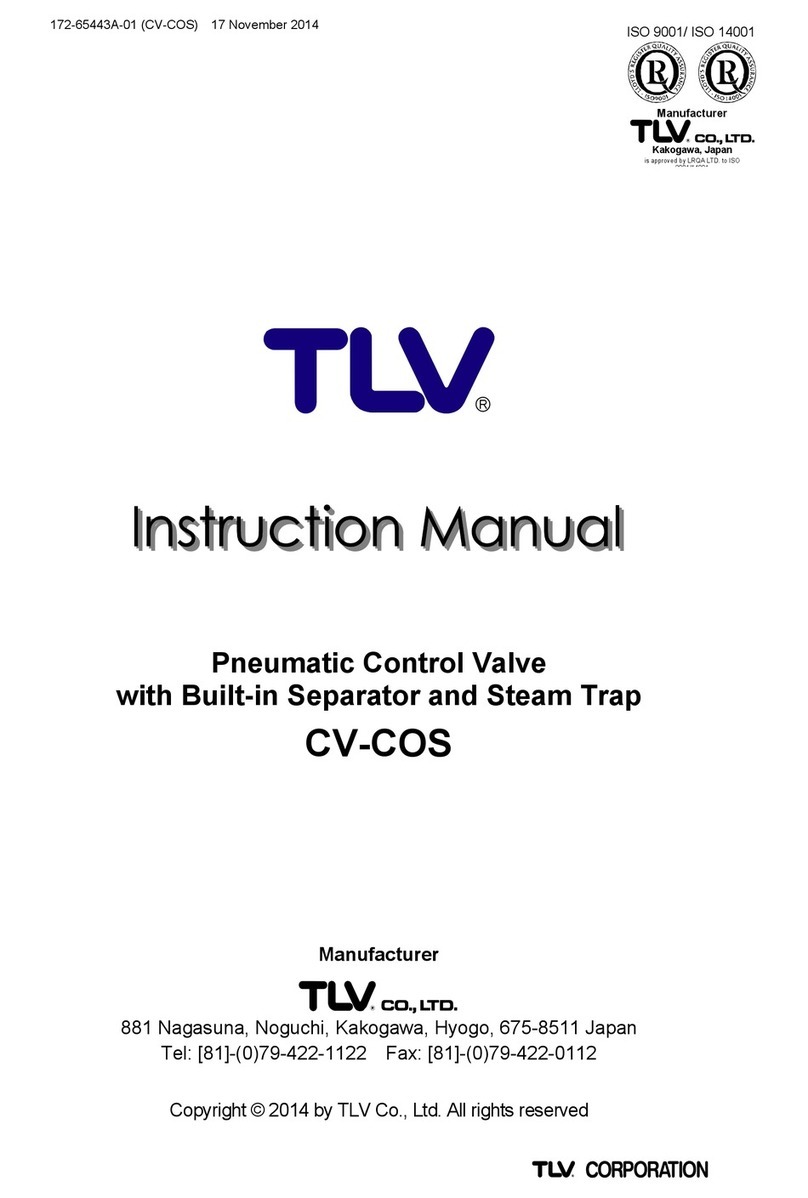KRUEGER Generation 3 PWM User manual

Fan Coil ECM Control IOM
FAN COIL EC MOTOR CONTROL ..............................................................3
G3 PWM BOARD..............................................................................................3
BALANCING UNITS WITH EC MOTORS ......................................................3
ADJUSTING EC MOTOR SPEED................................................................5
THREE SPEED (ADJUSTABLE) MOTOR CONTROL....................................5
2 – 10 VDC PROPORTIONAL MOTOR CONTROL.....................................6
EC MOTOR TROUBLESHOOTING GUIDELINES .......................................7
CHECKING EC WIRE HARNESSES................................................................9
EC MOTOR AND DRIVER...........................................................................9
TABLE OF CONTENTS

3
Fan Coil ECM Control IOM
FAN COIL EC MOTOR CONTROL
G3 PWM BOARD
The “Generation 3 PWM” (G3 PWM) board provides a pulse-
width modulated (PWM) signal to the EC motor to control
fan speed. The board is factory programmed to control
the motor in either Three Speed (adjustable) mode or
Proportional Control using a remote 2 – 10 V DC input signal.
In Proportional Control mode, a 2 – 10 V DC signal will control
EC motor speed between factory set minimum (Min) and
maximum (Max) values. For either control mode, fan on/off
control is enabled via the ‘G’ signal.
Tools Needed:
• Digital multimeter capable of measuring 30 volts AC/DC
and duty cycle
• Insulated 1/8” flat bladed screwdriver
• Mini Hook Test Clips for multimeter (optional)
BALANCING UNITS WITH EC MOTORS
ELECTRICAL SHOCK HAZARD. All power must be
disconnected prior to installation and servicing this
equipment. More than one source of power may be present.
Disconnect all power sources to avoid electrocution or
shock injuries. Refer to lock out tag out procedures.
1. Make sure there are no obstructions in the discharge
ductwork and/or at the plenum opening.
2. Locate the G3 PWM board in the control enclosure. Refer
to Figure 1 for location of test points TP3 and TP1, the
Configuration Switch, Speed Adjust Potentiometer, and
Reset Button.
3. Place Configuration Switch into Program Mode. Use
an insulated screwdriver to flip configuration switch
#1 (closest to speed adjust potentiometer) to the ON
position. See Figure 2.
PWM BOARD STATUS LED
The G3 PWM Status LED (refer to Figure 1) indicates the
status of the G3 PWM board. See Table 1, below.
G3 PWM STATUS DESCRIPTIONS
Normal - (Run mode) - If configuration switch 1 is in Run
Mode (OFF) the LED will flash to indicate Normal status.
Timed Out - (Program Mode) - The PWM board has a time
out function in Program Mode. If the PWM board has timed
out in Program Mode, the LED will flash. Time Out may be
cleared by pushing the Reset Button.
Error - (Run Mode) - If configuration switch 1 is in Run mode
(OFF) and the LED is always ON, there is a system error.
Verify all connections and proper input voltage at Line and
Com, then push the Reset Button. If this fails to return the
board to Normal mode, replace the board.
Program Mode - If configuration switch 1 is in Program
Mode (ON) the LED will be always ON to indicate that the
board is in Program Mode. See Figure 2, below.
NOTE: While in Program Mode, the fan motor will not run.
Fault - (Any mode) - If the LED remains OFF, the board either
has no power or is faulted. Verify proper input voltage at
Line and Com, then push the Reset Button. If this fails to
return the board to expected mode, replace the board.
Figure 1 – G3 PWM Board
Program
Analog
Hi/Max
Med
Lo/Min
2-10
O<2
Store
Run
Fxd Spd
0-10
Set
N
O
12345678
Figure 2 – Program Mode. (Configuration Switch 1 ON.)
TABLE 1: G3 STATUS LED DEFINITION
FLASH MODE INDICATES
Yes Run Normal
Yes Program Timed Out
Always On Run Error
Always On Program Program Mode
Always O Any Fault

4
Fan Coil ECM Control IOM
4. Press Reset button. Connect a voltmeter to test points
TP1 (-) and TP3 (+). Refer to Figure 1. Set voltmeter to DC
volts.
NOTE: The PWM board must be in Program Mode to
read voltage across TP1 and TP3.
5. Apply power to the unit. Verify that the status LED is
Always On, indicating that the PWM board is in Program
Mode. If the status LED blinks while in Program Mode,
the board has timed out. In this case, push the reset
button and verify the status LED returns to Always On.
NOTE: The PWM board times out in Program Mode after
approximately 5-6 minutes and will need to be reset
by pushing the reset button. If more time is needed
to verify correct airflow, perform the STORE operation
(through switch 8) after adjustment to save the adjusted
fan speed.
6. Determine desired fan operating points. Refer to the
Fan Calibration Curve label supplied on the side of
the equipment. There are two different styles of Fan
Calibration Curve, depending on EC motor type.
NOTE: The Fan Calibration Curve provided with the unit
represents response for a unit with typical configuration.
Actual airflow may vary slightly depending on actual
system configuration.
a. Constant RPM and Constant Torque EC Motor. Refer
to Figure 3a for sample label. Five curves are shown,
showing factory default airflow for Minimum, Low,
Medium, High, and Maximum speeds. A table is
provided which shows the expected voltage across
test points TP1 and TP3 for each speed, depending
on whether the unit is set up for three speed or 2 –
10 VDC motor control.
b. Constant Airflow EC Motor. Refer to Figure 3b for
sample label. Several curves are shown on the
label, one for each size unit. Refer to the 0 to 2.5 volt
scale on the label and use the voltmeter to read the
voltage across TP1 and TP3 to determine desired
airflow setting.
NOTE: Changing the factory setting for minimum
and maximum CFMs will invalidate the range for the
Fan Calibration Curve as it will narrow the scale of
the input signal.
7. Follow instructions for adjusting EC motor speed using
the G3 PWM board. Separate instructions are provided
for Three Speed (adjustable) and 2 – 10 VDC Proportional
motor control modes.
HORIZONTAL LOW PROFILE PLENUM SIZE 30 FAN CALIBRATION CURVE:
CONSTANT-RPM EC MOTOR
3 Row, 10 FPI, 1”Throwaway lter
0.50
Max
High
Medium
Low
Min
0.45
0.40
0.35
0.30
0.25
ESP (inches w.g.)
0.20
0.15
0.10
0.05
0.00
0 100 200 300 400
Airow (SCM)
43-10001-03, Rev. 00
500 600 700
2-10V
10.0 VDC
7.5 VDC
6.0 VDC
4.0 VDC
2.0 VDC
Max
High
Medium
Low
Min
Manual
0.88 VDC
0.70 VDC
0.53 VDC
0.35 VDC
0.18 VDC
Figure 3a – Constant RPM and Constant Torque EC Motors Example Fan
Calibration Curve
HORIZONTAL LOW PROFILE PLENUM
FAN CALIBRATION CURVE: CONSTANT-CFM EC MOTOR
Manual Adjustment Voltage (VDC)
0.50
60
50
40
30
25
20
0.45
0.40
0.35
0.30
0.25
0.20
0.15
0.10
0.05
0.00
2.0 2.8 3.6 4.4 5.2 6.0 6.8 7.6
Remote Analog Adjustment Voltage (VDC)
43-10008-01, Rev. 00
8.4 9.2 10.0
0.00 0.25 0.50 0.75 1.00 1.25 1.50 1.75 2.00 2.25 2.50
Figure 3b – Constant Airflow EC Motors Example Fan Calibration Curve

5
Fan Coil ECM Control IOM
ADJUSTING EC MOTOR SPEED
This section contains instructions for using the G3 PWM
board to adjust the EC motor speed for balancing purposes.
There are two modes of EC motor speed control: Three Speed
operation at three fixed (adjustable) speeds, or Proportional
Control with remote 2 – 10 VDC signal.
WARNING: For units with electric heat, fan speed must not
be adjusted below 70 CFM/kW.
Refer to Figure 1 for location of configuration switch, speed
adjust potentiometer, and reset button. These will be used to
program the EC operating mode and motor speed settings.
THREE SPEED (ADJUSTABLE) MOTOR CONTROL
High, Medium, and/or Low speed adjustment for three
speed operation. NOTE: Thermostat must be set for three
speed operation.
1. High Speed Setting Adjust: Set Configuration Switch to
HIGH SPEED adjust. (See figure A below.) Switches to ON-
OFF-ON-OFF-OFF-OFF-OFF-OFF.
• Set switch 1 to ON (Program)
• Set switch 2 to OFF (Fixed Speed)
• Set switch 3 to ON (Hi/Max)
• Set switches 4 through 8 to OFF
• Press RESET button. (NOTE: RESET button only needs
to be pressed once per programming session unless
board times out. Refer to Status LED.)
• Refer to voltmeter connected to TP1 and TP3. Using
an insulated 1/8” flat bladed screwdriver, adjust speed
potentiometer to desired high speed airflow per Fan
Calibration Curve on unit.
• STORE: Set switch 8 to Store (ON), wait one second,
then to Set (OFF), to save the value.
2. Medium Speed Adjust: Set Configuration Switch to
MEDIUM SPEED adjust. (See figure B below.) Switches to
ON-OFF-OFF-ON-OFF-OFF-OFF-OFF.
• Set switch 1 to ON (Program)
• Set switches 2 -3 to OFF
• Set switch 4 to ON (Med)
• Set switches 5 through 8 to OFF
• Refer to voltmeter connected to TP1 and TP3. Using
an insulated 1/8” flat bladed screwdriver, adjust speed
potentiometer to desired high speed airflow per Fan
Calibration Curve on unit.
• STORE: Set switch 8 to Store (ON), wait one second,
then to Set (OFF), to save the value
3. Low Speed Adjust: Set Configuration Switch to LOW
SPEED adjust. (See figure C below.) Switches to ON-OFF-
OFF-OFF-ON-OFF-OFF-OFF
• Set switch 1 to ON (Program)
• Set switches 2 -4 to OFF
• Set switch 5 to ON (Lo/Min)
• Set switches 6 through 8 to OFF
• Refer to voltmeter connected to TP1 and TP3. Using
an insulated 1/8” flat bladed screwdriver, adjust speed
potentiometer to desired high speed airflow per Fan
Calibration Curve on unit.
• STORE: Set switch 8 to Store (ON), wait one second,
then to Set (OFF), to save the value
4. Resume Normal Three Speed Operation: Set all
switches to OFF to resume normal three speed operation.
(See figure D below.)
Program
A. High Speed Adjust
Analog
Hi/Max
Med
Lo/Min
2-10
O<2
Store
Run
Fxd Spd
0-10
Set
N
O
12345678
A - High Speed Adjust
Program
B. Medium Speed Adjust
Analog
Hi/Max
Med
Lo/Min
2-10
O<2
Store
Run
Fxd Spd
0-10
Set
N
O
12345678
B - Medium Speed Adjust
Program
C. Low Speed Adjust
Analog
Hi/Max
Med
Lo/Min
2-10
O<2
Store
Run
Fxd Spd
0-10
Set
N
O
12345678
C - Low Speed Adjust
Program
D. Normal Three Speed Operation
Analog
Hi/Max
Med
Lo/Min
2-10
O<2
Store
Run
Fxd Spd
0-10
Set
N
O
12345678
D - Normal Three Speed Operation

6
Fan Coil ECM Control IOM
Program
E. Mode to 2–10 VDC Proportional Control
Analog
Hi/Max
Med
Lo/Min
2-10
O<2
Store
Run
Fxd Spd
0-10
Set
N
O
12345678
E - Mode to 2–10 VDC
Proportional Control
Program
F. Max Speed Adjust
Analog
Hi/Max
Med
Lo/Min
2-10
O<2
Store
Run
Fxd Spd
0-10
Set
N
O
12345678
F - Max Speed Adjust
Program
G. Min Speed Adjust
Analog
Hi/Max
Med
Lo/Min
2-10
O<2
Store
Run
Fxd Spd
0-10
Set
N
O
12345678
G - Min Speed Adjust
Program
H. Normal 2 – 10V DC Speed Control
Analog
Hi/Max
Med
Lo/Min
2-10
O<2
Store
Run
Fxd Spd
0-10
Set
N
O
12345678
H - Normal 2 – 10V DC Speed Control
4. Min Speed Adjust: Set configuration switches to LO/MIN
SPEED balancing mode. (See figure G below.) Switches to
ON-ON-OFF-OFF-ON-ON-OFF-OFF.
• Set switch 1 to ON (Program)
• Set switch 2 to ON (Analog)
• Set switches 3 and 4 to OFF
• Set switch 5 to ON (Lo/min)
• Set switch 6 to ON (2-10 V)
• Set switches 7 and 8 to OFF
• Refer to voltmeter connected to TP1 and TP3. Using
an insulated 1/8” flat bladed screwdriver, adjust speed
potentiometer to desired Min speed airflow.
• STORE: Set switch 8 to Store (ON), wait one second,
then to Set (OFF), to save the value.
5. Resume Normal 2 – 10 V DC Proportional Control:
Set configuration switches to OFF-ONOFF- OFF-OFF-
ON-OFF-OFF for normal proportional speed control, as
shown below in figure H.
• Set switch 2 to ON (Analog)
• Set switch 6 to ON (2 – 10)
• Set all other switches to OFF
2 – 10 VDC PROPORTIONAL MOTOR CONTROL
Speed range adjustment for Proportional Control operation.
Minimum (Min) and maximum (Max) speeds are programmed
at the factory for optimum operation. Changing factory Min
or Max speed defaults will change the motor effective speed
range and invalidate the voltage settings shown on the Fan
Calibration Curve. However, the speed range may still be
adjusted as long as the Min speed remains greater than 70
CFM/kW for units with electric heat.
NOTE: Thermostat must be set for either analog or single
(high) speed operation.
1. Connections. Connect or verify connection of remote
analog signal and common wires to 2-10 VDC Remote
Control Input terminals (refer to Figure 1.)
2. Set Mode to 2 – 10 VDC Proportional Control: Set
configuration switches to 2 – 10 ANALOG programming
mode. (See figure E at right.) Switches to ON-ON-OFF-
OFF-OFF-ON-OFF-OFF.
• Set switch 1 to ON (Program)
• Set switch 2 to ON (Analog)
• Set switches 3 – 5 to OFF
• Set switch 6 to ON (2-10 V)
• Set switches 7 and 8 to OFF
• Press RESET button. (NOTE: RESET button only needs
to be pressed once per programming session unless
board times out. Refer to Status LED.)
• STORE: Set switch 8 to Store (ON), wait one second,
then to Set (OFF), to save the value.
NOTE: If adjusting Min/Max CFM values, continue to step
3. Otherwise, skip to step 5.
3. Max Speed Adjust: Set configuration switches to HI/MAX
SPEED balancing mode. (See figure F at right.) Switches to
ON-ON-ON-OFF-OFF-ON-OFF-OFF.
• Set switch 1 to ON (Program)
• Set switch 2 to ON (Analog)
• Set switch 3 to ON (Hi/Max)
• Set switches 4 and 5 to OFF
• Set switch 6 to ON (2-10 V)
• Set switches 7 and 8 to OFF
• Refer to voltmeter connected to TP1 and TP3. Using
an insulated 1/8” flat bladed screwdriver, adjust speed
potentiometer to desired Max speed airflow.
• STORE: Set switch 8 to Store (ON), wait one second,
then to Set (OFF), to save the value

7
Fan Coil ECM Control IOM
EC MOTOR TROUBLESHOOTING GUIDELINES
Ensure motors and blowers are clean as part of normal maintenance. No further maintenance is required for these motors.
Warning! Follow standard lock out tag out (LOTO) procedures when performing service on motor or blower.
WARNING: Follow standard lock out tag out (LOTO) procedures when performing service on motor or blower.
TABLE 1: EC MOTOR TROUBLESHOOTING GUIDELINES
PROBLEM POSSIBLE CAUSE CORRECTIVE ACTION
Motor fails to start
No or loose enable jumper (Big Best manufactured constant RPM motor only) Verify enable jumper connected properly to motor driver. Refer to “Enable
Jumper” section (page 12).
No power to motor. Possible blown fuse or open circuit breaker Verify line voltage at motor driver. Replace fuse or reset circuit breaker.
PWM conguration switch in program mode Conguration switch 1 must be in Run mode (page 2, gure 2). Refer also to PWM
board status LEDs (page 1).
PWM board faulted Refer to PWM board status LEDs (page 1). Verify voltage input, wiring and
connections. Push reset button. Replace PWM board if fault returns.
No control signal (constant RPM)
Constant RPM EC motors will not rotate if they lose PWM signal while enabled.
Verify PWM signal at motor connector by connecting a multimeter set for “duty
cycle” between pins 1P1 and 1C (or between pins 2P1 and 2C). The duty cycle
represents the on-time percentage signal sent to the motor (this number will vary
between the minimum and maximum duty cycle set by the factory). See Figure 1
for PWM board connections (page 1). Refer also to PWM board status LEDs (page
1) to verify board is in normal operating mode.
Improper wiring connections Verify wiring. If Fan Coil Relay board present, verify all jumpers installed. Refer to
Fan Coil Relay Board Troubleshooting Guide.
EC motor wiring harness improperly seated Unplug harness and re-install, making sure plugs are fully seated.
EC motor wiring harness(es) open or intermittent Replace harness(es). See section on checking wire harnesses (page 9).
Blower jammed Clear blockage. Verify blower rotates freely with motor disconnected.
No 24 VAC power Refer to Fan Coil Relay Board Troubleshooting Guide.
Float switch tripped Verify oat switch (if present) is made.
Motor seized Verify motor rotates freely by hand with blower disconnected. If not, replace
motor.
Damaged motor cable Cable is integral to motor, replace motor.
Motor surges
Fan speed adjustment outside operating range
Refer to Fan Calibration curve on unit. Adjust speed on PWM Controller to value
that will allow motor to start. See instructions for Adjusting EC Motor Speed
(pages 4-5).
Blower Set Screw loose Tighten Screw onto motor shaft.
ESP (external static pressure) too high
Verify dampers, if present, are not closed. Verify there are no obstructions in the
discharge ductwork and/or at the plenum opening. Verify lter is not dirty and
does not obstruct airow.
Poor Performance
Lack of required external static pressure Add required external static pressure.
Speed adjustment outside fan operating range
Refer to Fan Calibration curve on unit. Adjust speed on PWM Controller to value
that will allow motor to start. See instructions for Adjusting EC Motor Speed
(pages 4-5).
Erratic speed command (in Proportional Control mode) Verify 2-10V analog signal at Remote Control Input terminals
Damaged or blocked blower Verify blower rotates freely. Clear blockage.

8
Fan Coil ECM Control IOM
TABLE 1 (CONTINUED): EC MOTOR TROUBLESHOOTING GUIDELINES
PROBLEM POSSIBLE CAUSE CORRECTIVE ACTION
Motor starts but stops.
Voltage or ground loss at motor driver Verify proper voltage and ground at motor driver power terminals. Refer to Motor
Driver Connections for the EC motor.
Motor overloaded - blower binding Clear blockage. Verify blower rotates freely with motor disconnected.
Motor overloaded Use amp meter to verify motor amps. Verify motor rotates freely with power
disconnected. If not, replace motor.
Open ductwork for concealed units Verify ducts sealed properly.
Motor overheated due to lack of airow
Verify dampers, if present, are not closed. Verify there are no obstructions in the
discharge ductwork and/or at the plenum opening. Verify lter is not dirty and
does not obstruct airow.
PWM board error or faulted Refer to PWM board status LEDs (page 1). Verify all connections. Push reset
button. Replace board if fault returns.
Motor driver failure Replace motor (Constant airow or constant torque motors.) Replace driver
(Constant RPM motor.)
Damaged motor cable Cable is integral to motor, replace motor.
Motor speed cannot be adjusted
PWM board error or faulted Refer to PWM board status LEDs (page 1). Verify all connections. Push reset
button. Replace board if fault returns.
Improper wiring connections Verify wiring. If Fan Coil Relay board present, verify all jumpers installed.
EC wiring harness damaged or improperly seated Unplug harness and re-install, making sure plugs are fully seated. See section on
checking wire harnesses, below. Replace harness if damaged.
No control signal (constant airow and constant torque)
Constant airow and constant torque EC motors will run at idle speed if they lose
PWM signal while enabled.
Verify PWM signal at motor connector by connecting a multimeter set for “duty
cycle” between pins 1P1 and 1C (or between pins 2P1 and 2C). The duty cycle
represents the on-time percentage signal sent to the motor (this number will vary
between the minimum and maximum duty cycle set by the factory). See Figure 1
for PWM board connections (page 1). Refer also to PWM board status LEDs (page
1) to verify board is in normal operating mode.
ESP (external static pressure) too high
Verify dampers, if present, are not closed. Verify there are no obstructions in the
discharge ductwork and/or at the plenum opening. Verify lter is not dirty and
does not obstruct airow.
Motor driver failure Replace motor (constant airow or constant torque motors)
Replace driver (constant RPM motors)
Motor runs in reverse, doesn’t
respond to speed adjustment Motor driver failure Replace motor (constant airow or constant torque motors)
Replace driver (constant RPM motors)
Excessive motor noise
Motor mounting bolts loose Tighten motor mounting bolts.
Motor bearing Replace motor.
Motor overloaded
Use amp meter to verify motor amps. Verify motor rotates freely with power
disconnected. If not, replace motor. Verify static pressure within limits shown on
Fan Calibration Curve on unit.
Fan wheel rubbing on fan housing Align wheel in housing.
Loose fan wheel Align and tighten.
Motor runs in G3 PWM Program
mode but not in Run mode Loose pin in Fixed Speed Conn. harness Verify that the pins in the Fixed Speed Conn. harness (see location in Figure 1 on
Page 1) are inserted fully.

9
Fan Coil ECM Control IOM
CHECKING EC WIRE HARNESSES
Use ohmmeter to verify that motor ground wire has
continuity from motor case to ground.
To check signal wire harnesses:
• Remove power from the unit. Unplug signal harness at EC
driver and from motor connector at PWM board.
• Use ohmmeter to check continuity for each conductor,
then reconnect harnesses to driver and to PWM board.
To check power wire harness:
• Refer to wiring diagram.
• Remove power from the unit. Unplug power harness at
EC driver.
• Verify green wire has continuity to ground.
• Unplug power wires from connections in electrical
enclosure. Verify continuity of wires to motor driver,
thenreconnect to same terminals.
Before reconnecting power to unit, verify all harnesses are
connected per diagram.
Use light force when inserting meter probe into plug. Excess
force will damage contacts.
EC MOTOR AND DRIVER
Depending on application, fan coil units can use three control
types for EC motors (both single and dual shaft):
• Constant RPM
• Constant Torque
• Constant Airflow
Constant Airflow/Constant Torque EC Motors
Constant CFM / Constant Torque EC Motor Driver Connections
Note that connections marked (n/u) are not used.
Figure 4 – Constant CFM / Constant Torque EC Motors (1/3 HP shown)
Figure 5 – Constant CFM / Constant Torque EC Motor Driver
SIGNAL
54321
5678 4 3 2 1
13141516 12 11 10 9
POWER
Figure 6 – Constant CFM / Constant Torque Driver Connectors
TABLE 2: SIGNAL CONNECTOR
PIN DESCRIPTION
1C1 (n/u - com)
2W/W1 (n/u)
3 C2 (PWM COM)
4DELAY (n/u)
5COOL (n/u)
6Y1 (n/u)
7ADJUST (n/u)
8OUT- (PWM FB)
9O (n/u)
10 PWM
11 HEAT (n/u)
12 R (n/u)
13 EM/W2 (n/u)
14 Y/Y2 (n/u)
15 G (Fan Enable)
16 OUT+ (PWM FB)

10
Fan Coil ECM Control IOM
Constant RPM EC Motors (Big Best Manufactured)
Figure 7 – Constant RPM EC Motor (1/4 HP shown)
Figure 8 – Constant RPM EC Motor Driver
Constant RPM EC Driver Connections
CON1
CON502
CON302
CON503
CON202
CON201
4
332211 3 2 144
3 2 1 45 3 3
2
2
1
1
Figure 9 – Constant RPM EC Motor Driver Connectors
TABLE 3: POWER CONNECTOR
PIN DESCRIPTION
1 Jumper pin 1 to pin 2 for 120
2VAC Line Input only
3Chassis Ground
4 AC Line (Line 1)
5AC Line (Line 2, Neutral)
TABLE 4: CON 1, POWER INPUT
PIN DESCRIPTION
1Ground
2 Neutral (or Line 2)
3 Line 1
TABLE 5: CON 503 (IF PRESENT) MOTOR ENABLE INPUT
PIN DESCRIPTION
1No Connection
2Signal Input
3Ground
TABLE 6: CON 502 (IF PRESENT) PROGRAMMING CONNECTOR
PIN DESCRIPTION
1+15V
2Ground
3TX-
4TX+
TABLE 7: FEEDBACK FROM EC MOTOR HALL SENSOR
PIN DESCRIPTION
1+5V
2Ground
3Hall ‘W’
4Hall ‘V’
3Hall ‘U’
TABLE 8: CON 302, PWM SIGNAL INPUT
PIN DESCRIPTION
4 Speed Control Input (H)
3 Speed Control Input (L)
2Speed Feedback Input (H)
1Speed Feedback Input (L)

11
Fan Coil ECM Control IOM
TABLE 9: CON 201, OUTPUT POWER TO EC MOTOR
PIN DESCRIPTION
1W1
2NC
3V1
4U1
Constant RPM EC Motor Driver Enable Jumper
The Constant RPM EC motor driver (Big Best manufactured)
has a Motor Enable Input. These drivers require a jumper
across the Enable Connector to allow the unit to operate.
See Figure 10 for jumper location across pins 2 and 3 of the
Enable Connector.
Figure 10 – Constant RPM EC Driver EC Motor Enable Connector
Constant RPM EC Driver Connections
567
8
4 3 2 1
1314 12 11 10 9
PWR/PWM MTR
5
4 3 2 1
876
Figure 13 – Constant RPM EC Motor Driver Connectors
Constant RPM EC Motors (Broad Ocean Manufactured)
Figure 11 – Constant RPM EC Motor (1/4 HP shown
Figure 12 – Constant RPM EC Motor Driver
TABLE 10: PWR/PWM CONNECTION
PIN DESCRIPTION
1 Signal COM
2-
3RPM
4-
5-
6-
7Ground
8-
9-
10 PWM
11 Jumper pin 11 to pin 12 for 120 VAC Line Input only
12 Jumper pin 11 to pin 12 for 120 VAC Line Input only
13 Line 1
14 Line 2 / Neutral
TABLE 11: MTR CONNECTION
PIN DESCRIPTION
1COM
2 HW (Hall Sensor)
3 HV (Hall Sensor)
4 HU (Hall Sensor)
5 W
6 V
7 U
8+5V

1401 N. Plano Rd.
Richardson, TX 75081
tel: 972.680.9136
www.krueger-hvac.com
Fan Coil Controls - G3 PWM Board: 09/22/2020
©Krueger 2020. All Rights Reserved.
YOUR RESOURCE FOR AIR DISTRIBUTION AND EQUIPMENT SOLUTIONS
Let us know how we can assist you in your next building application. For more information, contact
your local Krueger representative or visit us on the web at www.krueger-hvac.com.
CRITICAL ROOM SOLUTIONS
CHILLED BEAMS
DISPLACEMENT VENTILATION
UNDERFLOOR
Underoor Diusers
Underoor Terminal Units
TERMINAL UNITS
Single Duct
Fan Powered
Dual Duct
Bypass & Retrot
FAN COILS & BLOWER COILS
Horizontal
Vertical / Stack
DIFFUSERS
Plaque & Architectural
Louvered
Perforated
Modular Core
Linear Slot
Plenum Slot
Round
Air Nozzles
GRILLES & REGISTERS
Supply
Return
Linear Bar
Security
Industrial
Duct Mounted
Transfer
Stainless Steel
CONNECT WITH US!
This manual suits for next models
1
Table of contents
Other KRUEGER Control Unit manuals
Popular Control Unit manuals by other brands

Pentair
Pentair PROSTOP-E Installation and operation manual
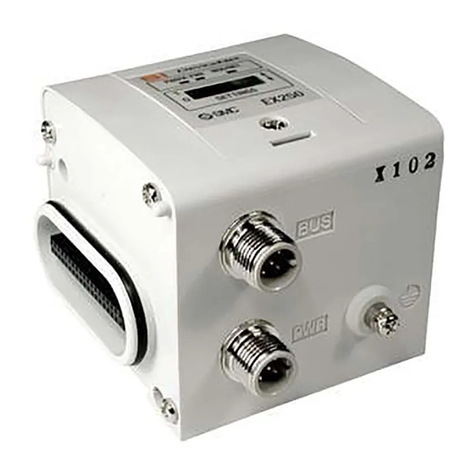
SMC Networks
SMC Networks EX250-SPR1 Operation manual
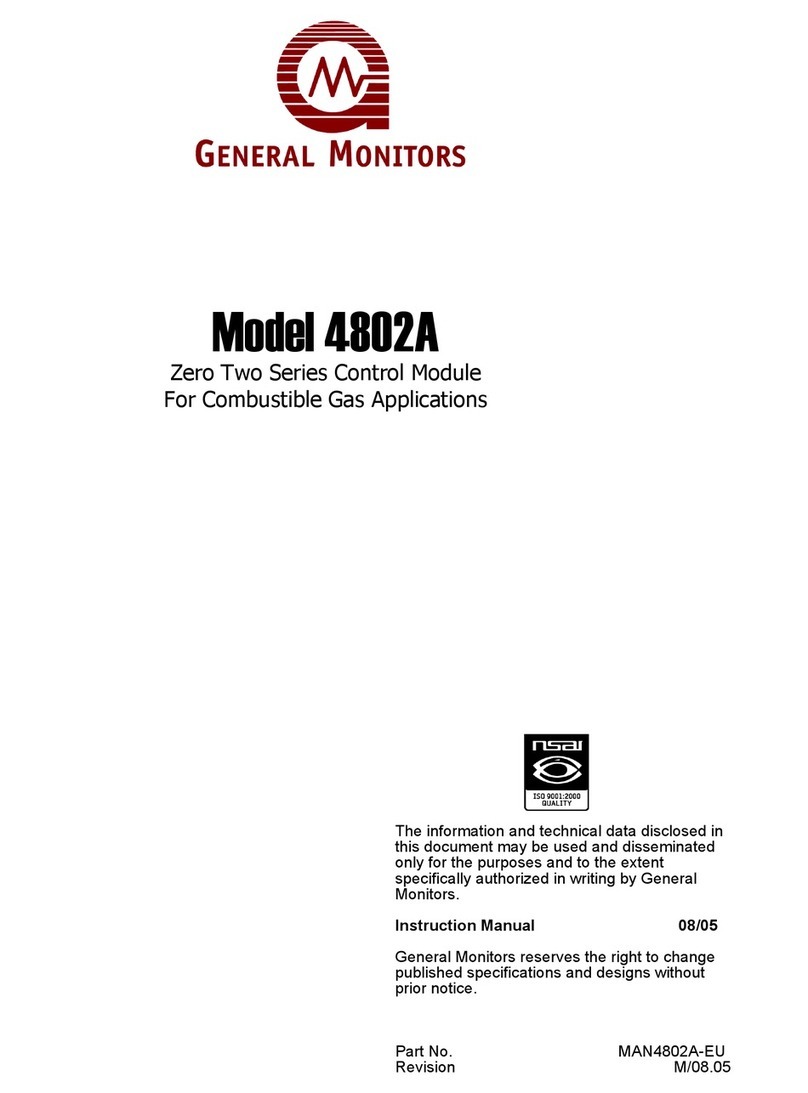
General Monitors
General Monitors 4802A instruction manual
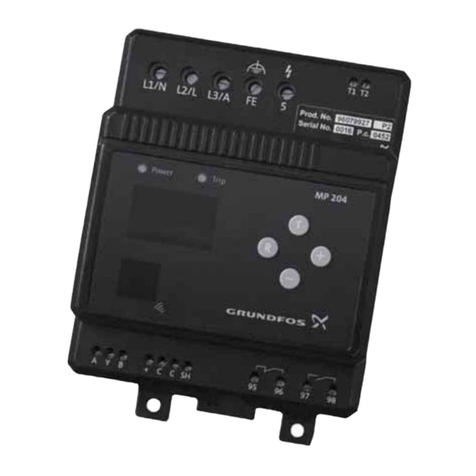
Grundfos
Grundfos MP 204 Installation and operating instructions
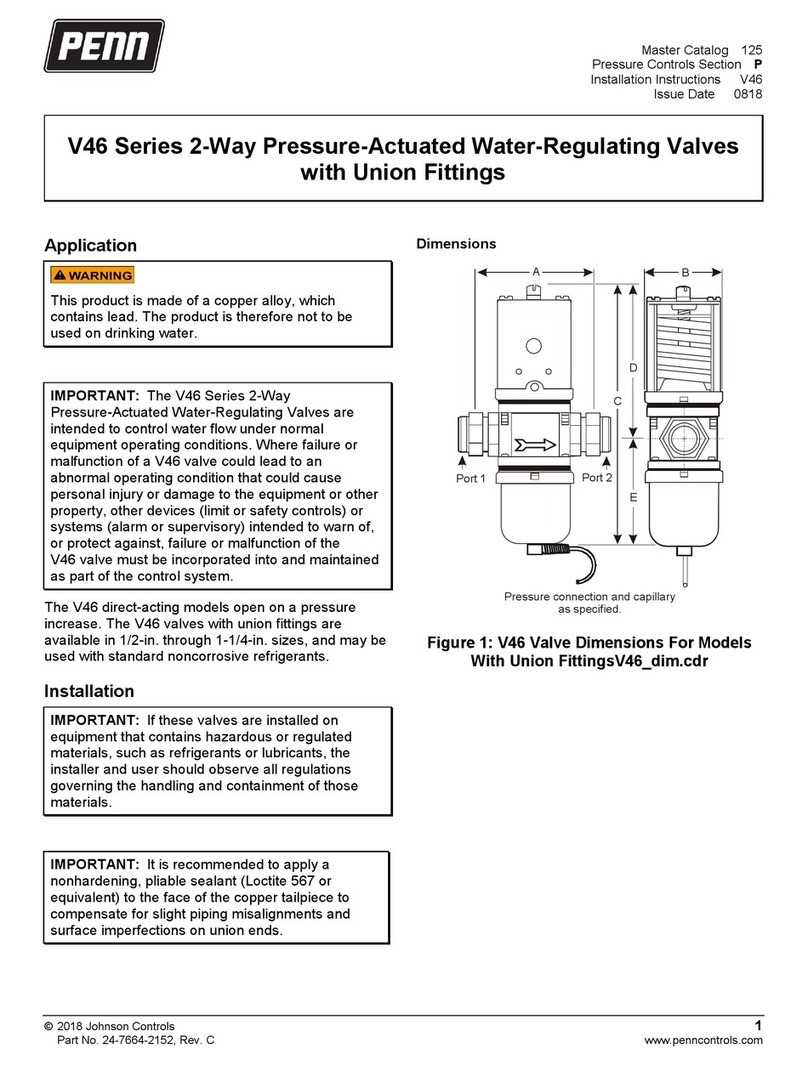
Penn
Penn V46 Series quick start guide

Game Winner
Game Winner HU2339101-GW quick start guide

ICP DAS USA
ICP DAS USA PM-3033 Series quick start
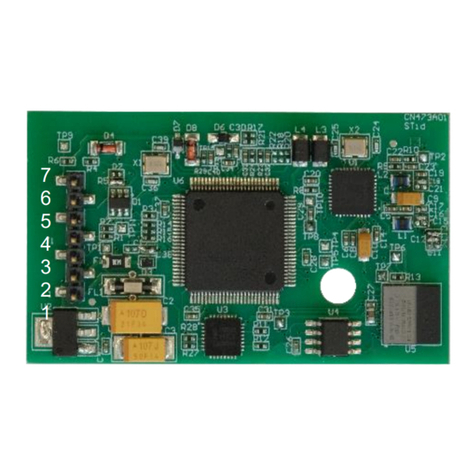
Stid
Stid MS2S-Blue installation instructions
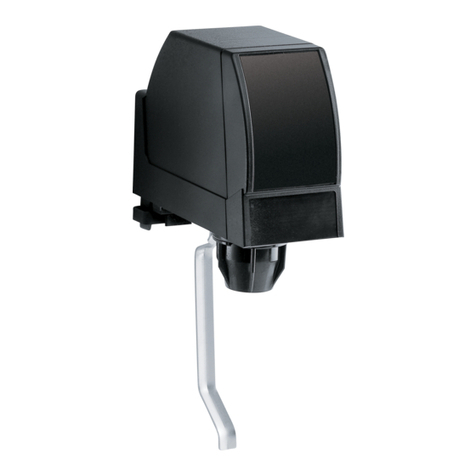
Cornelius
Cornelius Post-Mix Valves UFB-1 Installation and service manual
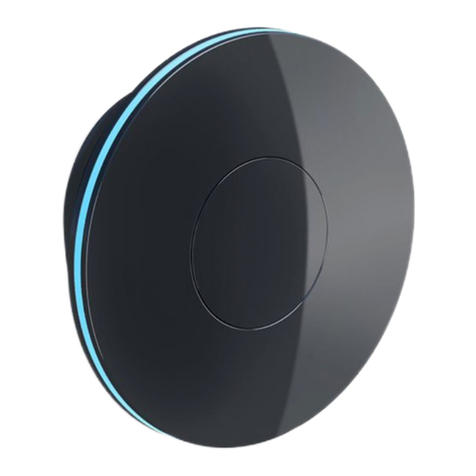
Tion
Tion IRM330 user manual
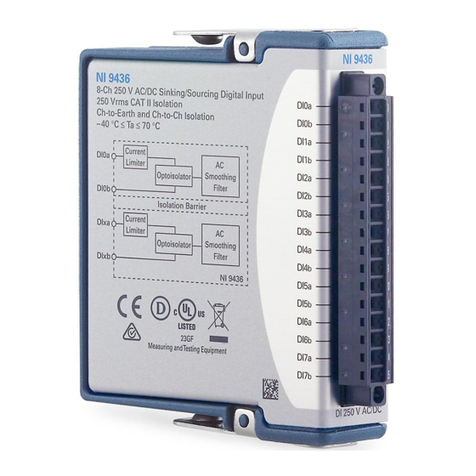
National Instruments
National Instruments NI 9436 Getting started guide

Panasonic
Panasonic AK-HCU250P operating manual

